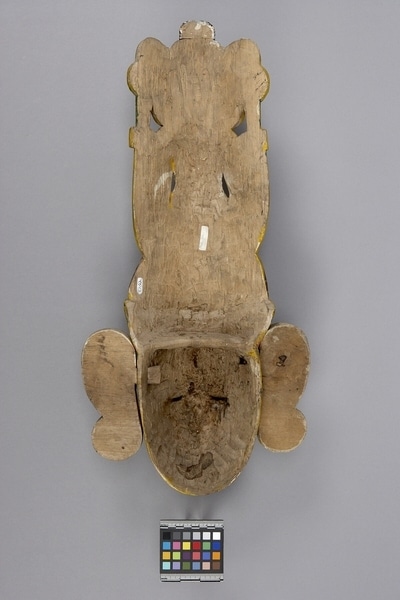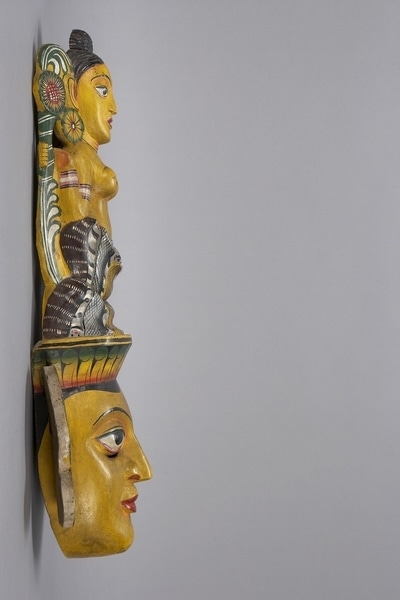Mask Item Number: Eh92 from the MOA: University of British Columbia




Description
Mask depicting a yellow humanoid face with earpieces attached via mortise and tenon joints, and wearing a tall headdress that consists of a female figure emerging from a series of cobras that curl up around her waist and down towards the top of the large head. The details of the mask are painted in green, red, black, white, and grey. Label on reverse written in blue ink reads, "Giri Devi."
History Of Use
The Kolam is a secular entertainment with considerable elements of social satire. It incorporates narrative, mime, dance, and music. A Kolam performance usually has four episodes the precise content of which may vary. These consist of a prelude, detailing the origin of the drama; the arrival of a royal party and dances by characters mythical, human and animal; enactment of a popular story or stories; and a purifying demon dance. This mask represents the mythical figure Giri, a goddess who became obsolete, now considered a demon figure, good natured towards human-beings. The mask is worn only by men. Dancers are dressed in white clothes with jackets and sashes, brass diadems, breast-plates, bangles and heavy anklets. Halved coconut shells under their blouses give the illusion of breasts.
Cultural Context
exorcism
Iconographic Meaning
Three main features: first, the naturalistic human face and figure represents zealous worshippers of Buddha; secondly, serpents symbolize the life force that motivates birth and rebirth. Nagas (cobras) are semi-divine, kapelles (snakes) represent sacred, deceased ancestors. Thirdly, Nari-lata, the bare breasted figure, expresses feminine beauty and charm, both exotic and sexually symbolic.
Item History
- Made in Sri Lanka
- Collected during 1978
- Owned by Jason Schoonover before June 10, 1982
- Received from Jason Schoonover (Seller) and Museum of Anthropology Shop Volunteers (Funding source) on June 10, 1982
What
Who
- Culture
- Sinhalese
- Previous Owner
- Jason Schoonover
- Received from
- Jason Schoonover (Seller) and Museum of Anthropology Shop Volunteers (Funding source)
Where
- Holding Institution
- MOA: University of British Columbia
- Made in
- Sri Lanka
When
- Collection Date
- during 1978
- Ownership Date
- before June 10, 1982
- Acquisition Date
- on June 10, 1982
Other
- Condition
- fair
- Current Location
- Case 106
- Accession Number
- 0812/0008